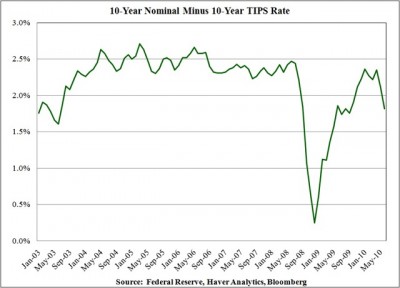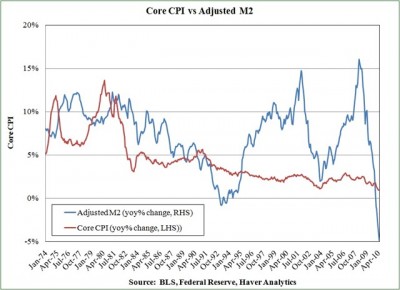It’s time to pay for lunch
Lately there has been much ink spilled (or at least the electronic equivalent) about the meaning in the downward shift of the yield curve, the significance of a two-year Treasury that sports a 5/8% yield, and a 10-year that trades in a new sub-3% range. Our admittedly unscientific impression is that the analysis initially centered on the flight to quality and safety that transpired once the troubles of Greece and greater Europe hit the market, transitioned to the uncertainty engendered by the finreg deliberations, and now reflects the market upping their handicapping of a much softer follow-through in America’s economic recovery. Unsurprisingly, we have not read or seen anything that suggests the reason for these microscopic rates is because the bond market vigilantes have become less vigilant. One would be hard-pressed to argue that the American government is a better credit today than it was in April when the two-year yield was twice as high and the 10-year was at 4%.
We think the answer may be the obvious one. Built into every interest rate is an expectation for inflation and—all other things being equal—rising or falling rates imply that investors believe that inflation will be either higher or lower going forward. The TIPs breakeven rate (the nominal 10-year yield minus the 10-year TIPS yield) is turning south, however, it is not outright deflationary like the scare of 2008.
The graph below or a version of it has been widely disseminated in different venues to demonstrate a) how the change in the monetary aggregates (and here we use a stand-in for the discontinued M-3, ie, M-2 plus large time deposits and institutional money market funds) had decoupled from core inflation over the last 20 years but b) how it now seems to have recoupled.
If inflation once again becomes a monetary phenomenon and that phenomenon is pointing to deflation, then policymakers are facing two conflicting and irreconcilable truths. On the one hand, the fiscal conservatives are absolutely correct that the current fiscal condition of our cities, states and nation is structurally unsound. Budgets are not in balance, and borrowing continues hand over fist (particularly at the national level). On the other hand, the risk of deflation is more real today than it was when the Fed last expressed concern about it in 2002-03. Critical segments of our economy are still struggling, and unemployment seems to be changing from a cyclical problem to a secular verity.
The solution for either of these problems will come at the direct expense of the other. True structural reform through austerity measures or higher taxes, could constrain already tepid economic growth and continue the deflationary trajectory. But deflation fighting through Keynesian means or even further quantitative easing is apt to aggravate the fiscal imbalances. America has enjoyed a free lunch for quite some time—our currency enjoys reserve status around the world, and we pay our debts with currency we alone print. We can’t escape the feeling that the check for lunch is about to come due.


We already know what the problem is, Mr. Annaly. Unfortunately, the 25 year assault on labor will never been seen as one of the chief reasons for this mess. One look at corporate balance sheets and supreme court decisions and it’s obvious that companies are more important than individuals in this errrrrr, democracy. Will be interesting to see how much longer people accept these inverted priorities. Equally interesting will be to watch how long the neo-fascists can hypnotize the ignorant into thinking that government is the problem. It’s gonna be scary, but at least it won’t be boring.
Speaking of “the governemnt is the problem” meme, I have two interesting posts for today’s links from the hardcore Austrian set. It will give you a sense of how these arguments function when taken to extremes.
One is on government regulation and the other is by Murray Rothbard on Milton Friedman and the Chicago School’s alleged statist tendencies.
well said … whilst everyone is starting to jump up and down as risky assets sag i doubt very much that in the short term policy makers will stop their market (rather than economic) propping policy. at some stage the need to change policy towards fixing household balance sheet will prevail rather than protecting special interest groups.